
USS Essex (CV/CVA/CVS-9) was an aircraft carrier and the lead ship of the 24-ship Essex class built for the United States Navy during World War II. She was the fourth US Navy ship to bear the name. Commissioned in December 1942, Essex participated in several campaigns in the Pacific Theater of Operations, earning the Presidential Unit Citation and 13 battle stars. Decommissioned shortly after the end of the war, she was modernized and recommissioned in the early 1950s as an attack carrier (CVA), eventually becoming an antisubmarine aircraft carrier (CVS). In her second career, she served mainly in the Atlantic, playing a role in the Cuban Missile Crisis. She also participated in the Korean War, earning four battle stars and the Navy Unit Commendation. She was the primary recovery carrier for the Apollo 7 space mission.
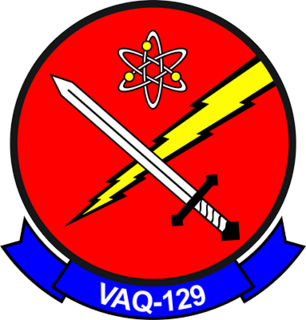
Electronic Attack Squadron 129 (VAQ-129) is the United States Navy's only EA-18G Growler training squadron. Known as the "Vikings", they are a Fleet Replacement Squadron, or FRS, and are charged with training all EA-18G aviators and developing standard operating procedures for the maintenance and operation of the aircraft. The squadron is permanently stationed at Naval Air Station Whidbey Island, in Puget Sound, Washington.
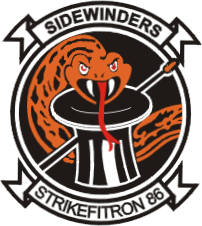
Strike Fighter Squadron 86 (VFA-86) is a strike fighter squadron of the United States Navy based at Naval Air Station Lemoore, California. The squadron is nicknamed Sidewinders, leading to the call sign Winder. The unit currently flies the F/A-18E Super Hornet and is assigned to Carrier Air Wing Seven, tail code AG.

A carrier air wing is an operational naval aviation organization composed of several aircraft squadrons and detachments of various types of fixed-wing and rotary-wing aircraft. Organized, equipped and trained to conduct modern US Navy carrier air operations while embarked aboard aircraft carriers, the various squadrons in an air wing have different but complementary missions, and provide most of the striking power and electronic warfare capabilities of a carrier battle group (CVBG). While the CVBG term is still used by other nations, the CVBG in US parlance is now known as a carrier strike group (CSG).

Attack Squadron 65 (VA-65), nicknamed The World Famous Fighting Tigers, was an attack squadron of the United States Navy. The squadron was established as Torpedo Squadron VT-74 in 1945, redesignated as VA-2B in 1946, as VA-25 on 1 September 1948, and finally redesignated VA-65 on 1 July 1959. It was disestablished in 1993. Known as "The World Famous Fighting Tigers", VA-65 was one of the last medium attack squadrons to fly the A-6 Intruder and the A-1 Skyraider. It was the second squadron to be designated VA-65, the first VA-65 was redesignated from VA-6B on 27 July 1948 and would be redesignated as VA-25 on 1 July 1959.

Strike Fighter Squadron 34 (VFA-34), also known as the "Blue Blasters", is a United States Navy F/A-18E Super Hornet strike fighter squadron stationed at Naval Air Station Oceana. They are a part of Carrier Air Wing 1 and are attached to the aircraft carrier USS Harry S. Truman. Their tail code is AB and their radio call sign is "Joker".

Strike Fighter Squadron 81 (VFA-81), also known as the "Sunliners", is a United States Navy F/A-18E Super Hornet strike fighter squadron stationed at Naval Air Station Oceana. They are a part of Carrier Air Wing One, their radio callsign is Inferno, and their tail code is AB. Their mission is to conduct prompt and sustained combat operations from the sea. The squadron was originally designated VA-66 on 1 July 1955, was redesignated VF-81 the same day, redesignated VA-81 on 1 July 1959, and finally redesignated VFA-81 on 4 February 1988.

Strike Fighter Squadron 83 (VFA-83), also known as the "Rampagers", are a United States Navy F/A-18E Super Hornet fighter squadron stationed at Naval Air Station Oceana. They are a part of Carrier Air Wing 3, their tailcode is AC and their radio callsign is Ram.
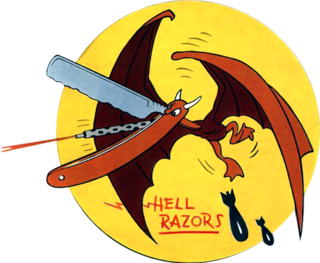
Attack Squadron 174 (VA-174) also known as the "Hellrazors" was a United States Navy attack squadron based at Naval Air Station Cecil Field, Florida, and were attached to Light Attack Wing One. It was commissioned from 1944 to 1988.

Carrier Air Wing Six (CVW-6) was a United States Navy aircraft carrier air wing whose operational history spans from the middle of World War II to the end of the Cold War. Established in 1943 as Carrier Air Group Seventeen (CVG-17), it would be re-designated several times during its establishment, including Carrier Air Group Six (CVG-6) as the second unit to be so designated. The first Carrier Air Group Six served for just over two years during World War II, but drew on the history of the Enterprise Air Group established in 1938 and active in the early battles of the Pacific War, being disestablished after the first year of the conflict. During its time in USS Enterprise (CV-6), it was the Navy's only carrier-based air group to carry out three complete tours of duty during World War II.

Strike Fighter Squadron 204 (VFA-204), also known as the "River Rattlers", is a U.S. Navy Reserve strike fighter squadron flying the F/A-18C/D Hornet. The squadron is based out of Naval Air Station Joint Reserve Base New Orleans and is part of the United States Navy Reserve's Tactical Support Wing. Their radio callsign is River and their tail code is AF.

Helicopter Sea Combat Squadron 9 (HSC-9) "Tridents" is a United States Navy helicopter squadron based at Naval Air Station Norfolk, Norfolk, Virginia (USA). The squadron is equipped with the Sikorsky MH-60S Seahawk. Currently, HSC-9 is attached to Carrier Air Wing Eight. It was originally established as Helicopter Anti-Submarine Squadron 3 (HS-3) in 1952 and was redesignated on 1 June 2009.
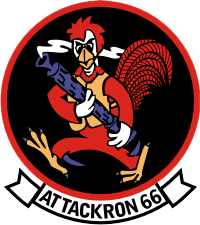
VA-66 was an Attack Squadron of the U.S. Navy; it was the second squadron to be so named. The squadron was called to duty and established as Reserve Fighter Squadron VF-671 on 1 February 1951. It was redesignated Fighter Squadron VF-81 on 4 February 1953, and finally as VA-66 on 1 July 1955. The squadron was disestablished on 1 October 1986, but one detachment continued in existence until 31 March 1987. The squadron's nickname was the Waldomen from the 1950s to the early 1960s, and the Waldos from that point forward. Its insignia, a rooster toting a machine gun, was a well-known design in naval aviation.

Attack Squadron 72 (VA-72) was an aviation unit of the U.S. Navy. It was established as Bomber Fighter Squadron 18 (VBF-18) on 25 January 1945. The squadron was redesignated as Fighter Squadron 8A (VF-8A) on 15 November 1946, as VF-72 on 28 July 1948, and finally as VA-72 on 3 January 1956. It was disestablished on 30 June 1991.

VA-76 was an Attack Squadron of the U.S. Navy. It was established on 1 June 1955 and disestablished on 30 September 1969. The squadron was nicknamed the Spirits, from its motto Fighting Spirits of 76.

VA-172 was an Attack Squadron of the U.S. Navy. It was established as Bomber Fighter Squadron VBF-82 on 20 August 1945, redesignated as Fighter Squadron VF-18A on 15 November 1946, as VF-172 on 11 August 1948, and as VA-172 on 1 November 1955. The squadron was disestablished on 15 January 1971. Its nickname was the Checkmates from 1946-1950, and the Blue Bolts thereafter.

VA-34, nicknamed the Blue Blasters, was an Attack Squadron of the U.S. Navy. The squadron was established as Fighter Squadron VF-20 on 15 October 1943, redesignated as VF-9A on 15 November 1946, as VF-91 on 12 August 1948, and as VF-34 on 15 February 1950. It was finally redesignated VA-34 on 1 July 1955. The squadron was disestablished on 1 June 1969. It was the second squadron to bear the VA-34 designation, the first one having been renamed VA-35 in 1950.
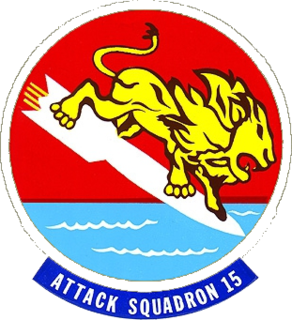
Attack Squadron 15 (VA-15), nicknamed the Valions, was an aviation unit of the United States Navy. It was established as Torpedo Squadron 4 (VT-4) on 10 January 1942, redesignated VA-2A on 15 November 1946, and finally redesignated VA-15 on 2 August 1948. The squadron was disestablished on 1 June 1969, after 27 years of service.

Attack Squadron TWELVE, also known as the "Flying Ubangis" or "Clinchers", was an attack squadron of the United States Navy active during the Cold War. From their home port at Naval Air Station Cecil Field in Florida, the squadron made more than thirty major overseas deployments aboard aircraft carriers, primarily flying A-4 Skyhawk and later the A-7E Corsair II, including two combat tours in the Vietnam War.

Carrier Air Wing Thirteen (CVW-13) was a carrier air wing of the United States Navy established for a short period at the end of the Cold War. There were three previous units which had been named Carrier Air Group Thirteen (CVG-13), dating as far back as 1942, though each of these units has a distinct lineage.






















